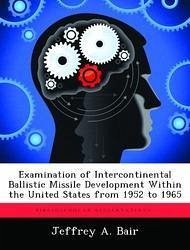
Examination of Intercontinental Ballistic Missile Development Within the United States from 1952 to 1965
Versandkostenfrei!
Versandfertig in über 4 Wochen
52,99 €
inkl. MwSt.

PAYBACK Punkte
26 °P sammeln!
Intercontinental ballistic missiles (ICBM) development by the United States from 1952 through 1965 is marked by extreme urgency. The initial impetus for the development did not proceed within military channels; this paper explores possible reasons why the military channels were not the originator of the program. These reasons include the competition for mission and resources an ICBM capability represented to manned strategic bombers. Significant technological breakthroughs and strong leadership from key individuals highlight the development process. The development of thermonuclear weapons hel...
Intercontinental ballistic missiles (ICBM) development by the United States from 1952 through 1965 is marked by extreme urgency. The initial impetus for the development did not proceed within military channels; this paper explores possible reasons why the military channels were not the originator of the program. These reasons include the competition for mission and resources an ICBM capability represented to manned strategic bombers. Significant technological breakthroughs and strong leadership from key individuals highlight the development process. The development of thermonuclear weapons helped make ICBMs possible, but no single technological breakthrough made the development of ICBMs possible. In the same way, the leadership was not generated by a single source. The leadership of General Bernard Schriever and Mr. Trevor Gardner represent a significant contribution to the journey. The management concept known as concurrency helped shorten the timelines and was teamed with a full employment of the weapon system concept and unprecedented authority within the organization responsible for the development were significant to the successful deployment. The last area examined is the revolution in military affairs produced by the mating of thermonuclear weapons and ballistic missiles as well as the deterrent policies of the administrations that provided the doctrine for this revolution.














